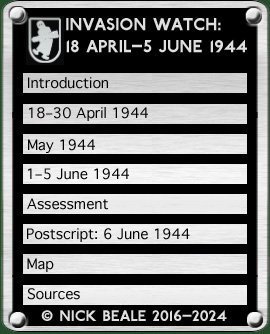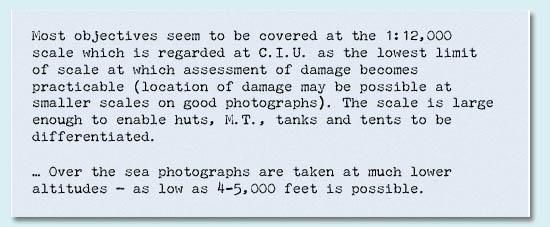
|
||
|
The 5.(F)/123’s “ideal” machine seems to have been a Bf 109 G-5/AS with just a single MG 151/20 cannon, MW 50 and an Rb 50/30 camera (offering good results at 6000 m or more). The Staffel appears to have been rebuilding since 30 March, when it had consisted of: 5 Bf 109 G-4, 2 Bf 109 G-5, 2 Bf 109 G-6 and 2 Fw 190 A-5 1 Bf 108 and 1 Fi 156 (communications aircraft) At that point, four of the Bf 109s and one Fw 190 had been absent or unserviceable while only three pilots had been ready for operations (one was conditionally ready, one on leave and seven detached). The 4. Staffel seemingly had many more G-6 sub-types, similarly equipped, but both units ended up flying a mixture and it appears that they were phasing out their Bf 109 G-4s during the Spring. There were a few Fw 190s distributed throughout NAG 13 and FAG 123 but no definite reports (in the sources I have so far consulted) of their being used over the Channel or British Isles during this period although they had flown frequently in March. The 4.(F)/123 gave up its last two in April while the 5. Staffel had some on strength until August. Over the Summer NAG 13 seems progressively to have concentrated its Focke-Wulfs into its 2. Staffel while withdrawing that unit’s Bf 109s. On the quality of German photography, S/L David Linton of the Allied Central Interpretation Unit at RAF Medmenham had this to say, based on captured examples:
On 4 January 1944, Oberbefehlshaber West (Generalfeldmarschall Gerd von Rundstedt) wrote to OKW regarding reconnaissance against England and the USA. He stated that: Luftflotte 3 has ordered reconnaissance of the east and south east coats of England with all available reconnaissance forces. Reconnaissance of the interior of the English Island [sic] is only practicable with the aircraft types to hand in exceptional cases. Quick in-and-out reconnaissance during fighter operations is aimed for. Night photo-reconnaissance takes place in the context of our own raids. However, Luftflotte 3 points to the special difficulties caused by the enemy’s defences and its own complete dependence on favourable weather conditions. Ob. West reports in this respect that since Autumn 1942, something approaching a lightning reconnaissance of the English southern and south eastern harbours, which alone can provide a clear picture of the places where shipping is being readied, no longer takes place. The one-off reconnaissances achieved since then are of very limited value for the assessment of the overall situation. So let us look now at what the German units actually did. Intelligence officers on the Allied side naturally interested themselves in what the Luftwaffe might be able to discover of Allied preparations for a cross-Channel invasion. Throughout the winter of 1943–44 they concluded that “no recce was being flown”, noting how Ob. West’s situation reports always included the formula “PR and visual recce provided no new information.” In a note of 1 October 1943 to its Admiralty clients, Bletchley Park’s Naval Section advised that: All reconnaissances in the Channel area and off the East Coast appears [sic] to have lapsed for the moment, no recce having been flown in either of these areas since the 24th of September On 21 January, according to the Kriegsmarine, “our aircraft carried out a photographic reconnaissance of the English south coast. Portsmouth, Southampton, Yarmouth (Isle of Wight) and Dartmouth were covered” but the British Air Operations Watch report does not suggest that they made landfall. It says rather that during the afternoon four NAGr. 13 aircraft staged though Cherbourg and reported sightings off Start Point while two more from Morlaix were to fly to the Lizard but called in no sightings. An entry in the Naval Staff diary for 8 February noted that after a two-month hiatus landing vessels were again arriving in the Channel from the Mediterranean but: “[with] a lack of comprehensive aerial reconnaissance unobserved changes are possible.” A successful photo-reconnaissance of Chatham Dockyard was carried out on 15 February, the German Naval Staff concluding that evaluation of the results had indicated nothing unusual. The diary of the Seekriegsleitung (Naval High Command) for 24 February includes the following: Photo-reconnaissance of Portsmouth, Yarmouth and Cowes was carried out at midday. Visual observation of motor torpedo boat activity in the Solent. Five quite large vessels were lying off Cowes. On the west side of the Iisle of Wight there was probably a fairly large net barrier. Photo-reconnaissance of London at [0700 GMT] on 21/2 from 1000 m altitude revealed in the Thames Estuary: 36 freighters, 2 T [tankers], 1 escort vessel, 7 picket boats and 2 apparent LCT outward bound from the Estuary; 1 paddle steamer and 15 fishing vessels inbound. In the bend of the Thames at Erith: 1 LCT, around 60 auxiliary landing craft, 1 T, 1 freighter, 5 apparent auxiliary landing ships. In the Thames bend at Woolwich about 60 apparent auxiliary landing craft. In the King George Dock: 1 battleship of the King George V class.
On the 25th, two Fw 190 from Lannion (attributed by the British to NAG 13) were plotted 40 km east of the Lizard at 12.15. Flying NW at 4000 m they crossed the coast near Falmouth seven minutes later and were reported to have dropped a bomb, which failed to explode, at Penhale on the outskirts of Helston. These aircraft also made three reports of shipping in the Channel. On 20 March the Kriegsmarine recorded that photo-reconnaissance of the southwestern point of the Cornish peninsula had revealed surprisingly meagre occupation of Penzance, Newlyn and Salcombe by smaller-capacity vessels: only two LCT 250, 22 auxiliary landing-craft and 22 Schuten (a type of barge) were pictured.
More productive was photography of Falmouth reported on the 23rd, showing a destroyer, nine LST, 21 large landing boats, four auxiliary landing craft, 3 freighters and 15 harbour and coastal vessels. continued on next page …
|
||||


